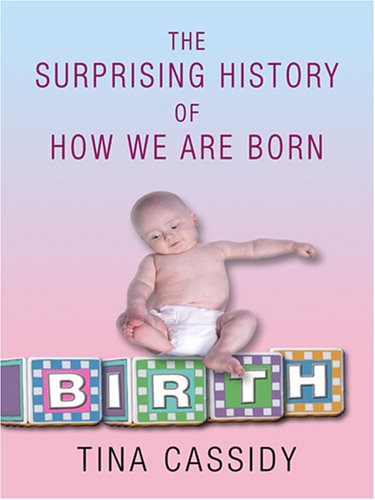Items related to Birth: The Surprising History of How We Are Born

"synopsis" may belong to another edition of this title.
But infrastructure is only the first problem. Human interference can make things much worse. In this breezy popular history, Cassidy, a former Boston Globe reporter and editor, surveys centuries of terrible childbirths around the world, attended by doctors, nurses and midwives with strange theories and, in more than a few cases, deeply sadistic streaks. Tirelessly wide-eyed, Cassidy details how laboring women have been strapped down and shackled, drugged into oblivion and ripped open with a macabre array of tools more suited to taxidermy than obstetrics. It's amazing anyone got out of the womb alive.
Childbirth fads and customs in Western cultures swing from one extreme to another and back again, Cassidy writes. First there were midwives, who were then replaced by doctors, recently unseated by a returning vogue for midwives. For centuries, babies were born at home, then women opted for hospitals; now, those hospitals are trying to make their delivery wards more "homey." Mothers breastfed for thousands of years, then they were told that formula was better. Now it's back to nursing. Painkillers are in, then they're out. And so it goes, literally ad nauseam.
It's not surprising that childbirth would be the focus of such ambivalence and anxiety. Throughout history, the making of children has been at once a low-odds proposition and a high-stakes affair -- not the joyful experience it is advertised as today but a matter of dowries, alliances and staffing up the farm. Maternal and neonatal death rates ran high at all levels of society. In male-dominated cultures, the fact that women were solely responsible for gestation and delivery must have been an affront. No wonder, then, that the attending women were eventually supplanted by male doctors.
Those doctors -- as early as the 16th century in Europe -- had startlingly little training and a severe distrust of the more experienced midwives. They were taught on makeshift mannequins and many hadn't even seen a live birth before they began to perform deliveries -- sometimes with their hands covered by a sheet, too embarrassed (or concerned for their patients' modesty) to look directly at the body parts they were working on.
Then came the hospitals. Cassidy points out that, for most of human history, the majority of women have given birth in or around their homes. Those who first delivered at American hospitals, starting in the 18th century, may have been at far greater risk of injury and death than their mothers. Doctors regularly moved from autopsies to live patients without ensuring sterile conditions -- or even washing their hands. They didn't know they had to. Some blamed the women themselves for the resulting infections, citing tight petticoats, loose morals and anxious "fretting" as causes. Even after germ theory became generally known, infant deaths from birth injuries in the United States jumped a shocking 50 percent between 1915 and 1929, Cassidy writes, because more women were giving birth in overcrowded, vermin-infested hospitals, where hand-washing still wasn't standard procedure and staff engaged in "aggressive" obstetrics that amounted to brutally wrenching the child out of its mother.
In contrast, women today seek out the best "birth experience," whether it's the "give me the epidural in the hospital parking lot" approach or multi-week Lamaze classes. But these so-called choices mask a less certain reality. Childbirth is unpredictable, and the best-laid birth plans are no guarantee. We are still ambivalent about this business, decrying the medicalization of childbirth but embracing its ability to get that newborn out safely if we hit a rough patch.
Cassidy has put together a concise survey, with more breadth than depth. Some of the material won't be all that surprising to anyone who has prepared for childbirth or at least paged through What To Expect When You're Expecting. But there's plenty of new gore for those who want it.
Oh, and there's more about that pelvis: It makes things hard in the months after birth, too. Over millennia, as human forebears got smarter and their brains grew larger, evolution found a balance: Since the pelvic opening can't grow any wider and still allow us to walk on two legs, babies' heads can't grow any bigger. This is why, Cassidy writes, our infants are born "altricial": With their brains still developing, they are helpless and in need of extended parental care. A shivering newborn calf can stumble to its feet within an hour after birth, but a human doesn't walk for about a year. Anatomy is destiny, in this case: Even after they make it through childbirth, parents are in for a long -- and bumpy -- ride.
Reviewed by Sara Sklaroff
Copyright 2006, The Washington Post. All Rights Reserved.
"About this title" may belong to another edition of this title.
- PublisherThorndike Pr
- Publication date2007
- ISBN 10 0786292695
- ISBN 13 9780786292691
- BindingHardcover
- Number of pages473
- Rating
Shipping:
FREE
Within U.S.A.
Top Search Results from the AbeBooks Marketplace
Birth : The Surprising History of How We Are Born
Book Description Condition: Good. Lrg. Former library book; may include library markings. Used book that is in clean, average condition without any missing pages. Seller Inventory # 2483280-6
Birth: The Surprising History of How We Are Born
Book Description Hardcover. Condition: Good. Examines the physical, political, social, religious, and anthropological factors that influence how women bring new life into the world, examining such topics as why birth can be difficult and the role of men during childbirth. Seller Inventory # SONG0786292695

